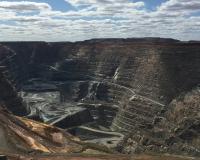
Vibrant Environment
Land Use And Natural Resources
All | Biodiversity | Climate Change and Sustainability | Environmental Justice | Governance and Rule of Law | Land Use and Natural Resources | Oceans and Coasts | Pollution Control

Lack of access to safe wastewater management infrastructure and improved sanitation is a global challenge that affects over 2 billion people worldwide. While large-scale wastewater treatment plants are common throughout the world, off-grid communities that exist outside of areas covered by centralized water infrastructure are often geographically isolated or economically marginalized, making these services not only unaffordable but inaccessible. In the absence of these networks, many communities have chosen to adapt. Although it is typically considered to be unlawful or illegitimate by their national governments, communities have begun to build decentralized systems to treat and reuse wastewater for agricultural purposes.

As the global community faces the reality that a rapid reduction in greenhouse gas (GHG) emissions is urgently required, a new class of climate change litigation is emerging. But what impact are these proceedings having?
A recent case from New South Wales (NSW), Australia, has directly challenged development that is at odds with GHG emission reduction targets. Hailed as a “landmark decision” in climate litigation, the case represents the first time an Australian court has refused a coal mining development consent not only on the basis of unacceptable “planning, visual and social impacts,” but also to prevent a new source of GHG emissions.

Interested in learning from leading scholars, policymakers, and practitioners about innovative policy proposals related to federal energy leasing, state preemption of local environmental initiatives, or free trade and enforcement of environmental laws? If so, you’ll want to attend the 12th annual Environmental Law and Policy Annual Review (ELPAR) conference on March 29, 2019, in Washington, D.C. The conference is free, and for those of you outside the D.C. area, it will also be available via webinar.

On February 14, 2019, EPA and the U.S. Army Corps of Engineers published a proposed rule revising the definition of “waters of the United States” (WOTUS) to redefine “federal authority under the Clean Water Act.” The proposed rule is the second part of the Trump Administration’s two-step process to repeal and revise the Clean Water Rule adopted in June 2015. The 2015 rule is currently in effect in 22 states as the courts sort out numerous challenges.

In litigation involving public lands, the first response from today's U.S. Department of Justice is almost always to contest plaintiffs’ standing.
U.S. Supreme Court decisions and numerous federal court decisions over the last several decades have effectively resulted in two evidentiary phases in most of these cases—first, proof of standing as a constitutional threshold, and second, only if standing is maintained, consideration of the evidence supporting the case on the merits. The standing phase is particularly relevant for public interest plaintiffs in public lands cases; it can require a more exacting showing from those seeking to vindicate public interests than from those asserting private economic interests.

In the late 1970s, revelations about the hazardous waste contaminating sites like Love Canal and Valley of the Drums captured the American public’s attention. In response to concerns about the risk these hazardous dumps posed to both public and environmental health, Congress passed the Comprehensive Environmental Response, Compensation, and Liability Act (CERCLA) in 1980. Commonly referred to as Superfund, CERCLA gives EPA the authority and resources to clean up and remediate sites contaminated by hazardous substances and pollutants.

On December 13, 2018, the U.S. Court of Appeals for the Fourth Circuit vacated permits issued by the U.S. Forest Service authorizing a pipeline, known as the Atlantic Coast Pipeline, to be constructed across two national forests and the Appalachian Trail. The Atlantic Coast Pipeline is a proposed 604-mile natural gas pipeline that would stretch from West Virginia to North Carolina.

Months after the devastating Camp, Woolsey, and Hill fires in California, the fallout of the blazes continues to rock the state. In the past month, PG&E, the state’s largest electric utility, transitioned out several top executives, had its credit rating downgraded to junk status, and was mandated to inspect its entire electric grid in a sharply worded court order. Last week, the company announced plans to file for bankruptcy by January 29. Citizens, insurance companies, and the state government are also feeling the heat as expected damage costs rise and climate change intensifies the frequency of wildfires. The strain on California’s public and private institutions foreshadows the difficult decisions to come across the fire-prone American West.

Natural resource mitigation—avoiding impacts to important species and habitat, minimizing impacts, and then providing offsets for remaining, residual impacts—is a valuable tool for developers and agencies to comply with the requirements of the National Environmental Policy Act, a variety of federal statutes that regulate impacts to important wildlife species and habitat, and/or public land management statutes requiring that uses of public lands be balanced with protection and conservation.

On the campaign trail, Brazilian President Jair Bolsonaro promised to eliminate existing protections of the Amazon. Despite some restrictions on his power to fulfill those promises, his administration will have a huge role to play in determining the delicate future of the earth’s largest rainforest, 65% of which is located within Brazil’s borders. Indeed, limiting the ability of agencies to enforce existing laws is more than sufficient to enable the proliferation of illegal logging, farming, and mining in the rainforest.